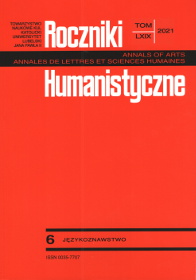A Contrastive Analysis from the Perspective of Cognitive Grammar—the Names of Body Parts in the Domain of Musical Instruments
Abstract
Proposing a methodology based on the assumptions of Cognitive Grammar, this article presents a contrastive analysis of metaphorical extensions in French and Polish or, more precisely, of the categorising relationships that constitute their foundations. The object of analysis is the names of body parts that refer to parts of musical instruments. The analysis assumes the description of different levels of abstraction of the similarities and differences in the categorising relationships: beginning with the highest level, through the schematic structure [part of the body] - - - > [part of the musical instrument], to the level of specific elaborations of this structure, i.e. the level of specific extensions. These lowest-level extensions are analysed at three levels of equivalence: lexical, referential, and that of the activated domains. This leads to the identification of several types of equivalence between the French and Polish elaborations of the above-mentioned schema.
References
Brenzinger, Matthias, et Iwona Kraska-Szlenk, éds. The Body in Language: Comparative Studies of Linguistic Embodiment. Brill, 2014.
Deignan, Alice, et Liz Potter. “A Corpus Study of Metaphors and Metonyms in English and Italian.” Journal of Pragmatics, vol. 36, 2004, pp. 123-252.
Dingemanse, Mark. “The Selective Advantage of Body-Part Terms.” Journal of Pragmatics, vol. 41, 2009, pp. 2130-2136.
Grzegorczykowa, Renata. „Idee kognitywizmu jako podstawa badań porównawczych w zakresie semantyki.” Etnolingwistyka, vol. 16, 2004, pp. 75-84.
Kraska-Szlenk, Iwona. “Semantic Extensions of Body Part Terms: Common Patterns and Their Interpretation.” Language Sciences, vol. 44, 2014. pp. 15-39.
Krzyżanowska, Anna. “Sur la place des noms d’émotion dans les études contrastives.” Studia Romanica Posnaniensia, vol. 42, Nº 5, 2015, pp. 67-79.
Langacker, Ronald. Foundations of Cognitive Grammar. Volume I: Theoretical Prerequisites. Stanford University Press, 1987.
Langacker, Ronald. “A dynamic usage-based model.” Usage-Based Models of Language, éds. Michael Barlow, et Susanne Kemmer, CSLI Publications, 2000, pp. 1-63.
Langacker, Ronald. “Grammaire, cognition et le problème de la relativité : le cas de la possession.” Langues et cognition, éd. Claude Vandeloise, Lavoissier, 2003, pp. 205-237.
Langacker, Ronald. Cognitive Grammar: A Basic Introduction. Oxford University Press, 2008.
Maalej, Zouheir, et Ning Yu, éds. Embodiment via Body Parts. John Benjamins Publishing Company, 2011.
Sharifian, Farzad, René Dirven, Ning Yu, et Susanne Niemeier, éds. Culture, Body, and Language: Conceptualizations of Internal Body Organs across Cultures and Languages. Walter de Gruyter, 2008.
Svorou, Soteria. The Grammar of Space. John Benjamins Publishing Company, 1994.
Taraszka-Drożdż, Barbara. Schémas d’extension métaphorique. À partir de l’analyse des contenus et des organisations conceptuels de certaines unités lexicales se référant à la lumière. Wydawnictwo Uniwersytetu Śląskiego, 2014.
Taraszka-Drożdż, Barbara. “Extension sémantique de l’unité lexicale dans la perspective de la grammaire cognitive – cas du corps des instruments de musique.” Linguistica Silesiana, vol. 39, 2018, pp. 237-248.
Waszakowa, Krystyna. “Perspektywy badań porównawczych w zakresie semantyki leksykalnej w świetle językoznawczych teorii kognitywnych.” LingVaria, vol. 1, Nº 7, 2009, pp. 49-64.
Copyright (c) 2021 Roczniki Humanistyczne

This work is licensed under a Creative Commons Attribution-NonCommercial-NoDerivatives 4.0 International License.





